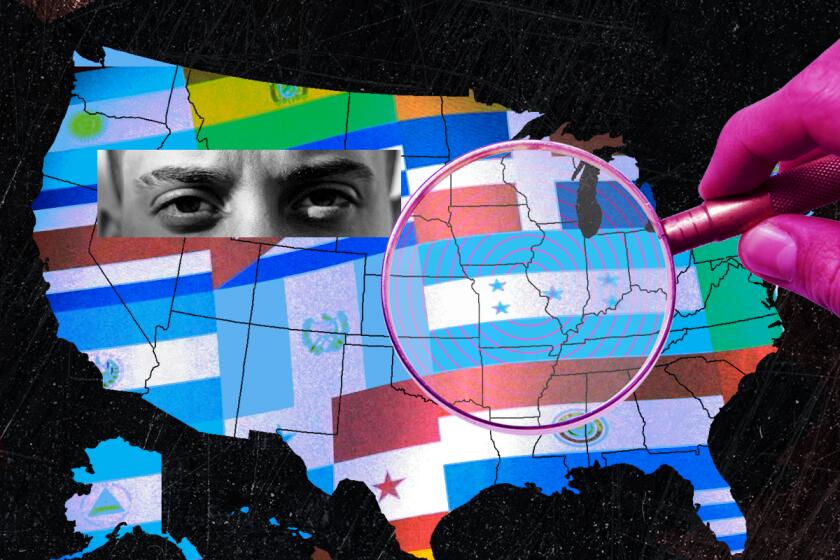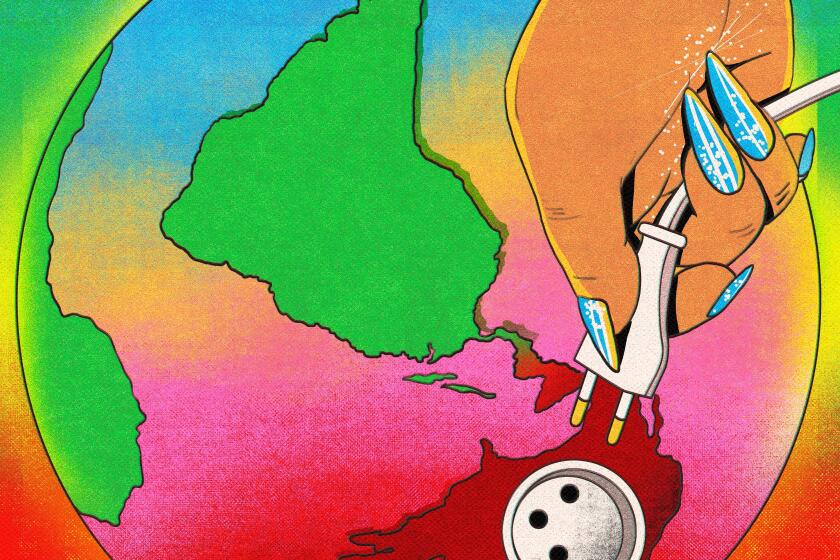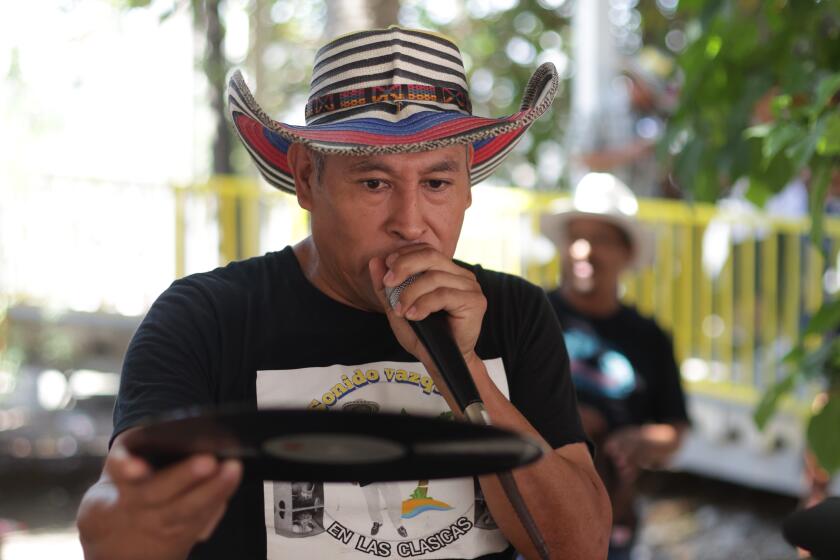
- Share via
I was born in America to Brazilian immigrant parents and thus am a citizen of both countries, but growing up with my first name in a conservative, white suburb has a way of othering you.
Before I took the preliminary SAT around 2005, I selected the “Hispanic/Latino” category when queried about my ethnicity. Months later, I started receiving unsolicited full scholarship offers from universities across America, calling me a National Hispanic Scholar. My parents were delighted but concerned: Had I somehow claimed Hispanic heritage and misrepresented my identity? After I provided further information on my background, every offer was unceremoniously rescinded.
The program has since shifted to allow students of Brazilian descent to qualify. This makes no sense given that it is called the National Hispanic Recognition Program, but some sense given that a significant subset of Brazilian Americans identify as Latino and the U.S. continues to regard Hispanic and Latino as synonymous. If you force us to check an inaccurate box, at least grant us the benefits that box can provide.
The concept of Latinidad in the U.S. is changing. One byproduct of recent shifts might be more room for Brazilian Americans to have a voice in a conversation that has typically excluded them.
Most also say it’s not necessary to speak Spanish to be considered Latino, the Pew Research Center analysis found.
Seventy-eight percent of Latino adults in America, up from 71% in 2015, now say it is not necessary to speak Spanish to be considered Latino, according to a new Pew Research Center poll.
The same Pew poll revealed a corresponding decrease in the percentage of Latino adults who said they could carry on a conversation in Spanish, from 82% to 75%, and who thought it was at least somewhat important for future generations of Latinos to speak the language, from 95% to 85%.
Those trends portend a broader Latinidad community for future generations, perhaps including people like me. Brazilians clearly don’t fit as Hispanics, but meet the traditional criteria to be considered Latino. Yet, since 1997, just before a critical mass of Brazilian Americans emerged, the U.S. government has formally excluded us from both categories, redundantly treating Latino as no different than Hispanic. Exceptions and gaffes have only complicated matters.
There might be more of us than you realize. Brazil’s Ministry of Foreign Affairs last estimated, in 2021, that more than 1.9 million Brazilians reside in America, or about 3% of the Latino population in the U.S. Though the U.S. Census estimate is about one-third of that, both bureaus agree the number is rising. Since 2000, the Census estimate has increased by more than 300%. According to the Migration Policy Institute, the Mexican immigrant population has increased just 16% since 2000. According to Pew estimates, the overall Latino immigrant population has increased about 41%.
According to a recent analysis from Pew Research, 78% of U.S. Hispanics say it is not necessary to speak Spanish in order to be considered Hispanic. Within the group of Latinos who don’t speak Spanish, however, 54% say they have been shamed because of it.
Within a 2003 study of Brazilian identity in America, Harvard sociologist Helen Marrow explained that the Office of Management and Budget’s official definition of Hispanic/Latino identity encourages Brazilians not to identify in the category — “first by presenting a formal definition alongside the census question that excludes groups not of ‘Spanish origin or culture’, and second by ‘cleaning’ some of their ‘other Hispanic’ responses outside this group.”
Still, Marrow’s study found 77% of Brazilian American youth said they considered themselves Latin American, and 55% said they considered themselves Latino or Latina. Only 41% said Spanish-speaking Latin Americans included them when they used the terms Latino or Latina.
Why only 55 or 77%? Consider that Brazil has its own longstanding issues with ethnoracial classification, and a conception of race dramatically different than many Americans’ white-Black binary. The first Brazilian census, in 1872, when enslaved people still represented more than 15% of the population, registered a plurality of mixed-race, officially pardo but colloquially moreno, residents.
An infamous 1976 survey by the Brazilian Institute of Geography and Statistics that asked residents to describe their skin color netted 136 disparate responses, including, as translated by a University of São Paulo professor, 21 variations on white and 23 on moreno. In last year’s Brazilian census, pardo people were once again the plurality.
UCLA’s Latino Data Hub is looking to provide statistics to help ensure a more accurate and nuanced understanding of Latinos in the United States.
Yet, likely because of income inequality that favors white people, studies show that the majority of Brazilian immigrants to America, my parents included, arrive here perceiving themselves as white. It is this country’s collective gaze that renders them Latino.
A 2020 Census Bureau mistake revealed that many, if not most, Brazilian Americans accept that.
Official practice calls for the bureau to back-code anyone who identifies as both Brazilian and Latino as not actually Latino, but that year they failed to complete the coding. Officially, there were 30 times as many Brazilian Latinos in 2020 as compared to 2019. The same mistake affected people of other origins, like Filipino, Belizean or Portuguese, but not to near the same extent.
The problem of Latino exclusion applies mostly to Brazilians, and mostly in the United States. As Pew has written: “The use of the terms ‘Hispanic’ and ‘Latino’ to describe Americans of Spanish origin or descent is unique to the U.S. and their meaning continue to change and evolve. Outside of the U.S., these terms are not widely used and may also have different meanings.”
A staggering 81% of Latinos in the U.S. consider addressing climate change to be a priority compared to 61% of non-Latinos, according to Pew Research.
As an example: the term “Latino” in Brazil refers more expansively to descendants of any culture that speaks a Romance language.
Part of the problem might be Brazil’s long-standing separation from the rest of Latin America. None of the five largest Brazilian cities are within a 1,000-kilometer drive from a Spanish-speaking city, and fewer than 1 million Brazilians live in countries where Spanish is the most spoken language, according to the Brazilian Ministry of Foreign Affairs. For example: The ministry reports that far more Brazilians live in the Hartford, Conn., metropolitan area than in all of Mexico. Mexico’s population is more than 100 times larger than the Hartford area’s.
Notably, the language barrier is porous. Fluent Portuguese and Spanish speakers can often understand each other, at least to some degree. For many years, my father communicated with a Honduran co-worker in a blend of the two languages, known as Portuñol or Portunhol.
The barrios of La Indepe used to be the margins of the industrial city, but now they are encircled by urban development. Given the government’s initiatives, often presented as progress, these barrios are the last obstacle standing in the government’s way.
So, why the continued separation between Brazilians and Latinidad?
I’d guess there are a few main reasons. It is only within the last generation that Brazilian Americans have materialized as a significant population, so few American adults grew up knowing anyone of Brazilian descent. Unfamiliarity can breed contempt, too, or just division. Many Brazilian Americans, myself included, have come to delight in feeling special, distinct from the rest, even if that exoticism also serves to other us in detrimental ways. And, yeah, we don’t speak the same language.
But it’s not as if the existing Hispanic or Latino parameters group together only identical people. Latinidad has long included a sweeping array of people and cultures. I would never propose even fewer Americans become bilingual in the service of minority unity, but if Spanish becomes less essential to the identity, maybe there will be more unity to be found.
More to Read
The Latinx experience chronicled
Get the Latinx Files newsletter for stories that capture the multitudes within our communities.
You may occasionally receive promotional content from the Los Angeles Times.












